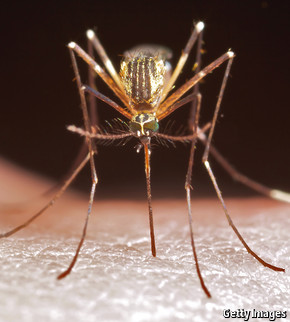
Have you experienced a malaria infestation before? Who hasn’t, you may say. There are some africans who have never had malaria, though Africa is an endemic region. But if you have and continually do, then you will heave a sigh of relief at this news. See some statistics also.
According to the World Health Organisation (WHO), there were about 200m cases of malaria around the world in 2010, with 660,000 deaths, 90% of which were in Africa, mostly of young children. The prospect of a vaccine is therefore exciting to patients and health experts alike. But developing one is difficult. Malarial parasites, though small and single-celled, are much more complex than the bacteria and viruses that are the usual targets of vaccines. To date there has been no successful vaccine against such a complex organism. Work on RTS,S has been going on for decades.
A case of malaria starts when a mosquito’s bite delivers parasites into a person’s bloodstream. These travel to the liver, where they hide, mature, multiply and eventually emerge back into the bloodstream to invade and destroy its red cells. The vaccine contains a protein found on the surface of the parasite, combined with an antigen for hepatitis B that prompts an immune response, plus an added immune-system booster. RTS,S seems to provoke antibodies and killer cells that attack the parasite before it leaves the liver.
The most ambitious clinical trial of a malaria vaccine has shown some effectiveness in children over an 18-month period. While its efficacy is modest, it is nonetheless a significant advance in the long struggle to control a disease that kills some 600,000 people a year, mostly children under the age of 5.
The trial, conducted at 11 research centers in seven African countries, involved more than 15,000 patients who took a new malaria vaccine developed by GlaxoSmithKline or a non-malarial vaccine given to control groups. Young children who were 5 months to 17 months old when first vaccinated with the Glaxo vaccine had 46 percent fewer cases of clinical malaria than the control groups. Infants who were 6 weeks to 12 weeks old when first vaccinated had 27 percent fewer cases.
Glaxo spent more than $350 million over 25 years to develop the vaccine for military personnel and travelers and expects to invest an additional $260 million to complete development. But Glaxo was reluctant to pay for pediatric trials in impoverished nations on its own, so the Bill and Melinda Gates Foundation provided $200 million through the nonprofit PATH Malaria Vaccine Initiative to drive development and testing over the finish line.
If the results hold up after further follow-up, the vaccine will be the first ever shown to be effective on a large scale against a disease-causing parasite, an organism that is much harder to neutralize than viruses or bacteria. The vaccine attacks the parasite at its earliest stages, before it can multiply in the liver and re-enter the bloodstream to infect red blood cells. The trials were conducted in real-world conditions in which a large majority of young children and infants were already protected by sleeping under insecticide-treated bed nets and other prevention measures. The vaccine protected them further.
The Gates Foundation called the trial “an important scientific milestone” for demonstrating that developing a vaccine against a parasite is possible. Glaxo said it would seek a scientific opinion from the European Medicines Agency next year in hopes that the World Health Organization will recommend the vaccine’s use as early as 2015. There are still scientific and practical hurdles to surmount — a final judgment on safety and efficacy and an analysis of the public health impact and cost-effectiveness of using this vaccine. With no other broadly tested vaccine on the immediate horizon, we can hope Glaxo’s passes muster.
No comments:
Post a Comment